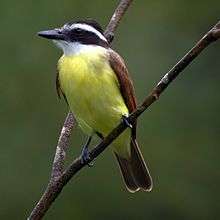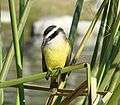Great kiskadee
| Great kiskadee | |
|---|---|
 | |
| Scientific classification | |
| Kingdom: | Animalia |
| Phylum: | Chordate |
| Class: | Aves |
| Order: | Passeriformes |
| Family: | Tyrannidae |
| Genus: | Pitangus |
| Species: | P. sulphuratus |
| Binomial name | |
| Pitangus sulphuratus (Linnaeus, 1766) | |
| Synonyms | |
| |
The great kiskadee (Pitangus sulphuratus) is a passerine bird. It is a large tyrant flycatcher; sometimes its genus Pitangus is considered monotypic, with the lesser kiskadee (P. lictor) separated in Philohydor.
It breeds in open woodland with some tall trees, including cultivation and around human habitation, mainly found in Belize, and from the Lower Rio Grande Valley in southern Texas and northern Mexico south to Argentina and Uruguay, but also it occurs all over Venezuela and Brazil (specially the central and south-southeastern regions), Paraguay and central Argentina, the Guyana coastline, and on Trinidad. It was introduced to Bermuda in 1957, and to Tobago in about 1970.
Description
The adult great kiskadee is one of the largest of the tyrant flycatchers. It can measure from 21 to 27 cm (8.3 to 10.6 in) in length and weigh 52 to 68 g (1.8 to 2.4 oz).[2][3] The head is black with a strong white eyestripe and a concealed yellow crown stripe. The upperparts are brown, and the wings and tail are brown with usually strong rufous fringes. The bill is short, thick, and black in color. The similar boat-billed flycatcher (Megarynchus pitangua) has a more massive black bill, an olive-brown back and very little rufous in the tail and wings. A few other tyrant flycatchers — the social flycatcher (Myiozetetes similis), for example — share a similar color pattern, but these species are markedly smaller.
The call is an exuberant BEE-tee-WEE, and the bird has an onomatopoeic name in different languages and countries: In Brazil its popular name is bem-te-vi ("I saw you well") and in Spanish-speaking countries it is often bien-te-veo ("I see you well") and sometimes shortened to benteveo.[4][5]
 |
The song and call of the great kiskadee.
|
| Problems playing this file? See media help. | |
Ecology
The great kiskadee is a common, noisy and conspicuous bird. It is almost omnivorous, and hunts like a shrike or flycatcher, waiting on an open perch high in a tree to sally out to catch insects in flight, or to pounce upon rodents and similar small vertebrates. It will also take prey and some fruit[6] from vegetation by gleaning and jumping for it or ripping it off in mid-hover, and occasionally dives for fish or tadpoles in shallow water, making it one of the few fishing passerines. They like to hunt on their own or in pairs, and though they might be expected to make good use of prey flushed by but too large for the smaller birds of the understory, they do not seem to join mixed-species feeding flocks very often. When they do, they hunt in the familiar manner. Such opportunistic feeding behavior makes it one of the commonest birds in urban areas around Latin America; its flashy belly and its shrill call make it one of the most conspicuous.[7]
The nest, built by both sexes in a tree or telephone pole, is a ball of sticks with a side entrance. The typical clutch is two or three cream eggs lightly blotched with reddish brown. They are incubated by the female.
This alert and aggressive bird has a strong and maneuverable flight, which it uses to good effect when it feels annoyed by raptors. Even much larger birds are attacked by the great kiskadee, usually by diving down or zooming straight at them while they are in mid-air. Harsh calls are also often given during these attacks, alerting all potential prey in the area of the predator's presence. If not very hungry, any raptor subject to a great kiskadee's mobbing behavior is likely to leave, as it is well-nigh impossible to make a good catch when subject to the tyrant flycatcher's unwelcome attention. In general, avian predators are liable to steer clear of an alert great kiskadee, lest their hunting success be spoiled, and will hunt the great kiskadee itself – though it is as meaty as a fat thrush – only opportunistically.

To mammalian and squamate predators that can sneak up to nesting or sleeping birds, it is more vulnerable however. Even omnivorous mammals as small as the common marmoset (Callithrix jacchus) will try to plunder great kiskadee nests – at least during the dry season when fruits are scarce – despite the birds' attempts to defend their offspring.[8] One of two birds studied in the Parque Nacional de La Macarena of Colombia was parasitized by microfilariae.[9]
The bright coloration of the great kiskadee makes it easy to recognize and as noted above, is shared by several other more or less closely related Tyrannidae. It is not known whether this apparent convergent evolution is a case of mimicry, and if so, whether the great kiskadee's pugnaciousness encourages some predators to leave birds with such colors well alone. Given that some Tyrannidae are alleged to taste bad, the color may also be an aposematic warning of noxious chemicals contained in the birds' meat. In a peculiar coincidence, the foxface rabbitfish (Siganus vulpinus) and related species have evolved a strikingly similar coloration and pattern; here it is almost certain that the colors are aposematic, as these fishes use a poisonous sting to defend themselves.
Not being appreciated as a songbird, the great kiskadee is not usually kept caged and therefore has escaped the depredations of poaching for the pet trade. Also, its feeding mostly on live prey makes it extremely difficult to keep in captivity. It is not considered threatened by the IUCN.[1][10]
Image gallery
 Benteveo in Buenos Aires (Argentina)
Benteveo in Buenos Aires (Argentina) Eating a banana in Belmopan, Belize
Eating a banana in Belmopan, Belize Bem-te-vi in Rio de Janeiro Botanical Garden (Brazil)
Bem-te-vi in Rio de Janeiro Botanical Garden (Brazil) Cristofue in San Salvador (El Salvador)
Cristofue in San Salvador (El Salvador) Bathing in a fountain
Bathing in a fountain Close-up (Montevideo, Uruguay)
Close-up (Montevideo, Uruguay)- Güi in [[Granada (Nicaragua)
- Perching on a fence

 Great kiskadee in McAllen, TX
Great kiskadee in McAllen, TX Cristofué or pecho amarillo inCosta Rica
Cristofué or pecho amarillo inCosta Rica- Great kisakadee (Pitangus sulphuratus) eggs from a nest near El Copey de Dota, Costa Rica
- Great kisakadee (Pitangus sulphuratus) nest near El Copey de Dota, Costa Rica
- Great kisakadee (Pitangus sulphuratus) nest at the edge of a cow paddock near El Copey de Dota, Costa Rica
 Great Kiskadee in Selva Verde, Costa Rica
Great Kiskadee in Selva Verde, Costa Rica.jpg)
Footnotes
- 1 2 BirdLife International (2012). "Pitangus sulphuratus". IUCN Red List of Threatened Species. Version 2013.2. International Union for Conservation of Nature. Retrieved 26 November 2013.
- ↑
- ↑
- ↑ Template:Citation. The Kiskedee name also refers to the bird call. The Naturalist Vincent Roth Claimed that the characteristic bird cry was taken by the early French settler to Guiana to be "que's Kil Dit".
In page 62, Charles Darwin calls it Saurophagus sulphureus. He says "The Saurophagus sulphureus is typical of the great American tribe of Tyrant-flycatchers. [...] In the evening the Saurophagus takes its stand on a bush, often by the road-side, and continually repeats, without change, a shrill and rather agreeable cry, which somewhat resembles articulate words. The Spaniards say it is like the words, "Bien te veo "(I see you well), and accordingly have given it this name."
See it also in The Complete Work of Charles Darwin Online - ↑ "Pitangus sulphuratus". Avibase.
- ↑ E.g. of Tamanqueiro (Alchornea glandulosa) or Gumbo-limbo (Bursera simaruba): Pascotto (2006), Foster (2007).
- ↑ Machado (1999), de A. Gabriel & Pizo (2005), Pascotto (2006)
- ↑ de Lyra-Neves et al. (2007)
- ↑ Basto et al. (2006)
- ↑ BLI (2008)
References
- Basto, Natalia; Rodríguez, Oscar A.; Marinkelle, Cornelis J.; Gutierrez, Rafael & Matta, Nubia Estela (2006): Haematozoa in birds from la Macarena National Natural Park (Colombia). Caldasia 28(2): 371-377 [English with Spanish abstract]. PDF fulltext
- de A. Gabriel, Vagner & Pizo, Marco A. (2005): Foraging behavior of tyrant flycatchers (Aves, Tyrannidae) in Brazil. Revista Brasileira de Zoologia 22(4): 1072–1077 [English with Portuguese abstract]. doi:10.1590/S0101-81752005000400036 PDF fulltext
- de Lyra-Neves, Rachel M.; Oliveira, Maria A.B.; Telino-Júnior,Wallace R. & dos Santos, Ednilza M. (2007): Comportamentos interespecíficos entre Callithrix jacchus (Linnaeus) (Primates, Callitrichidae) e algumas aves de Mata Atlântica, Pernambuco, Brasil [Interspecific behaviour between Callithrix jacchus (Linnaeus) (Callitrichidae, Primates) and some birds of the Atlantic forest, Pernanbuco State, Brazil]. Revista Brasileira de Zoologia 24(3): 709–716 [Portuguese with English abstract]. doi:10.1590/S0101-81752007000300022 PDF fulltext.
- ffrench, Richard; O'Neill, John Patton & Eckelberry, Don R. (1991): A guide to the birds of Trinidad and Tobago (2nd edition). Comstock Publishing, Ithaca, N.Y.. ISBN 0-8014-9792-2
- Foster, Mercedes S. (2007): The potential of fruiting trees to enhance converted habitats for migrating birds in southern Mexico. Bird Conservation International 17(1): 45-61. doi:10.1017/S0959270906000554 PDF fulltext
- Hilty, Steven L. (2003): Birds of Venezuela. Christopher Helm, London. ISBN 0-7136-6418-5
- Machado, C.G. (1999): A composição dos bandos mistos de aves na Mata Atlântica da Serra de Paranapiacaba, no sudeste brasileiro [Mixed flocks of birds in Atlantic Rain Forest in Serra de Paranapiacaba, southeastern Brazil]. Revista Brasileira de Biologia 59(1): 75-85 [Portuguese with English abstract]. doi:10.1590/S0034-71081999000100010 PDF fulltext
- Pascotto, Márcia Cristina (2006): Avifauna dispersora de sementes de Alchornea glandulosa (Euphorbiaceae) em uma área de mata ciliar no estado de São Paulo [Seed dispersal of Alchornea glandulosa (Euphorbiaceae) by birds in a gallery forest in São Paulo, southeastern Brazil.]. Revista Brasileira de Ornitologia 14(3): 291-296 [Portuguese with English abstract]. PDF fulltext
- Stiles, F. Gary & Skutch, Alexander Frank (1989): A guide to the birds of Costa Rica. Comistock, Ithaca. ISBN 0-8014-9600-4
External links
| Wikimedia Commons has media related to Great kiskadee. |
| Wikispecies has information related to: Pitangus sulphuratus |
- Bermuda Online: Bermudian Fauna.
- Bermuda Government Kiskadee Profile (with sound)
- List of Mexican Birds from the Museo de las Aves
- Stamps (for Argentina, Brazil, British Honduras-(Belize), Guyana, Nicaragua, Suriname, Uruguay, Venezuela) at bird-stamps.org
- "Great kiskadee media". Internet Bird Collection.
- Great kiskadee photo gallery at VIREO (Drexel University)
- Great kiskadee species account at NeotropicalBirds (Cornell University)
- Great kiskadee Species Account – Cornell Lab of Ornithology
- Interactive range map of Pitangus sulphuratus at IUCN Red List maps

